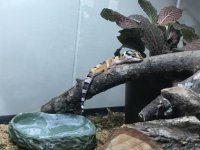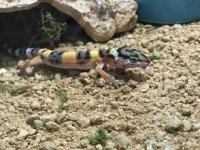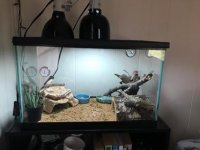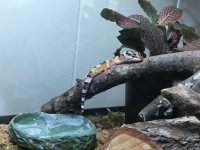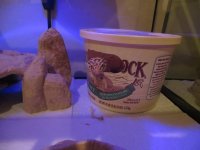desert_rat
New member
Hi guys,
So I'm a newbie/not-so-newbie. In highschool I had a friend who went to college and needed to rehome her adult leopard gecko. She came armed with all the goods, and I never questioned any of it. My gecko lived a happy and healthy life until it came time for me to also go to college (couldn't have a gecko in the dorms) and she was rehomed again where she lived another 4 happy years.
Here I am 8 years later and I wanted another gecko! So here I am, me and my cold blooded little buddy, a week in, and I'm realizing I really am not as confident in my abilities to provide him a habitat as I thought I was.
I've done a lot of research but there are SO many controversial topics and so I'm here to try and get some clarification. I'll give you some info on what I've got going:
1. My gecko (he's a little bitty guy right now, couple/few months old) is in a 10 gallon terrarium currently. I plan to expand when he grows. Substrate is the Exo-Terra Sand Mat. The first gecko I had used a sand substrate and never had an issue, and since that's their natural substrate in the wild it only makes sense, but I decided to heed the warnings of sand impaction and went with this mat.
2. I do have two hides - one warm, one cool and moist (using spaghum moss). I have a heat pad under the warm side of the habitat/hide.
3. This is where things got confusing for me. Additional heat/lighting, specifically with UVB. This is what I HAVE:
An incandescent 75W light - it gives off some heat, mostly just using it for photoperiod purposes. However, the habitat still has been too cool - he leaves his hide to explore but seems to quickly return to the heat pad. So I have recently added a ceramic heat emitter, and it's keeping the habitat much warmer (warm side stays about 90, cool side is about 82).
I didn't get a UVB light because from what I've read, they don't use it very much since they're crepuscular The set up I have now seems to be doing the job, but will UVB increase my gecko's quality of life? Or is incandescent light and the ceramic emitter and heat pad doing enough? So long as I'm maintaining photoperiod and adequate temps?
I AM using Reptivite with D3 on food (crickets and mealworms, though he hasn't shown any interest in the crickets yet), but I just need some assurance that that's enough! I'm not confident that synthetic supplementation is as good as the real thing - as what they evolved with. Should I switch to a UVB light? And if so, what wattage is recommended for a leo?
I know this is all kind of a jumbled mess, I just want to make sure I'm doing what's best! Thanks in advance.
So I'm a newbie/not-so-newbie. In highschool I had a friend who went to college and needed to rehome her adult leopard gecko. She came armed with all the goods, and I never questioned any of it. My gecko lived a happy and healthy life until it came time for me to also go to college (couldn't have a gecko in the dorms) and she was rehomed again where she lived another 4 happy years.
Here I am 8 years later and I wanted another gecko! So here I am, me and my cold blooded little buddy, a week in, and I'm realizing I really am not as confident in my abilities to provide him a habitat as I thought I was.
I've done a lot of research but there are SO many controversial topics and so I'm here to try and get some clarification. I'll give you some info on what I've got going:
1. My gecko (he's a little bitty guy right now, couple/few months old) is in a 10 gallon terrarium currently. I plan to expand when he grows. Substrate is the Exo-Terra Sand Mat. The first gecko I had used a sand substrate and never had an issue, and since that's their natural substrate in the wild it only makes sense, but I decided to heed the warnings of sand impaction and went with this mat.
2. I do have two hides - one warm, one cool and moist (using spaghum moss). I have a heat pad under the warm side of the habitat/hide.
3. This is where things got confusing for me. Additional heat/lighting, specifically with UVB. This is what I HAVE:
An incandescent 75W light - it gives off some heat, mostly just using it for photoperiod purposes. However, the habitat still has been too cool - he leaves his hide to explore but seems to quickly return to the heat pad. So I have recently added a ceramic heat emitter, and it's keeping the habitat much warmer (warm side stays about 90, cool side is about 82).
I didn't get a UVB light because from what I've read, they don't use it very much since they're crepuscular The set up I have now seems to be doing the job, but will UVB increase my gecko's quality of life? Or is incandescent light and the ceramic emitter and heat pad doing enough? So long as I'm maintaining photoperiod and adequate temps?
I AM using Reptivite with D3 on food (crickets and mealworms, though he hasn't shown any interest in the crickets yet), but I just need some assurance that that's enough! I'm not confident that synthetic supplementation is as good as the real thing - as what they evolved with. Should I switch to a UVB light? And if so, what wattage is recommended for a leo?
I know this is all kind of a jumbled mess, I just want to make sure I'm doing what's best! Thanks in advance.
Last edited:



